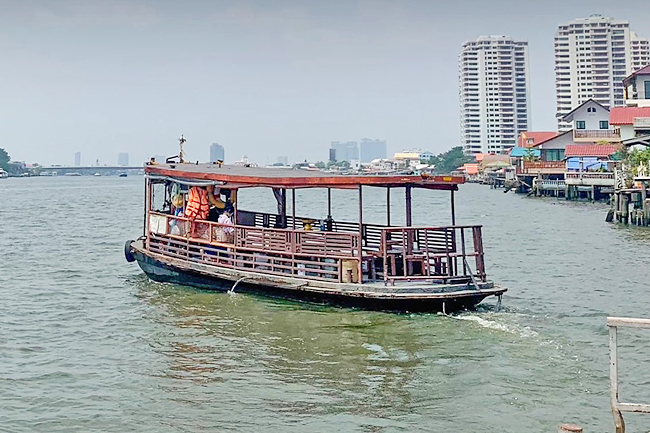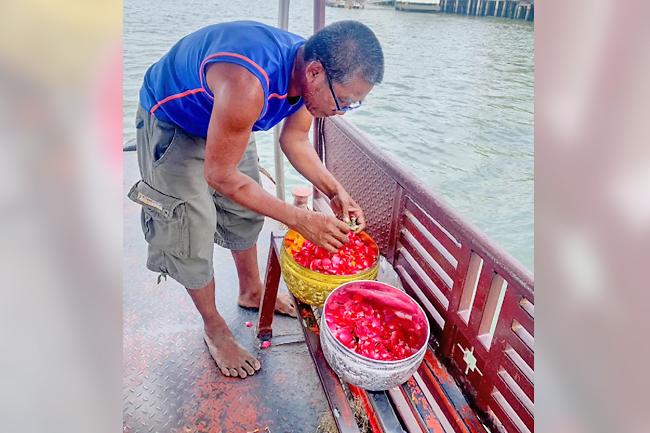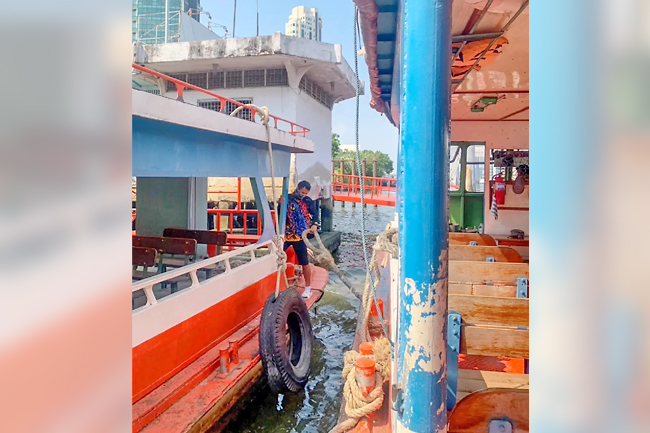ANN/THE NATION – Bangkok, the capital of Thailand, is home to the mighty Chao Phraya River. Cutting the big capital in half and branching into countless canals, the river is one of the main modes of transportation for many locals. Piers line both banks waiting to greet boats both large and small.
Passenger boats, tourist boats, cargo vessels and more travel this busy waterway. But while most are sailing north or south, river ferries do the opposite, carrying passengers from one side of the river to another. So what is life like on a small boat that only has two destinations in its whole life?
SHIPS AHOY!
Not far from Khemaphitaram temple is a small pier where Suruth “Rut” Sannonth moors his small metal ferry. Passed down to him from his father, Rut’s ferry business is one of the few independent operations left. Most have been taken over by big boat companies.
The service starts at 4am but Rut’s day begins at 3.30am. Most of his passengers are regulars. The first group are the monks from Kangkao temple doing pindapata, the practice of collecting alms in the morning, on a route across the river. They are followed by people who start work early. The main group of passengers – schoolchildren – arrive when the sun comes up.
Rut remembers his frequent customers. And if any of them hasn’t boarded the ferry back home in the evening, he either waits until they come or calls to check on them. Rut does not mind extending his hours as he has plenty of time to nap during the day when he has no passengers.
“The last ferry ride depends on those regulars. Sometimes if they need to take a ferry back late, they will call me to see if the ferry is still here.” Rut said, adding that he will often wait for them,
Downriver at Sathorn Pier, 38-year-old An works as a sailor on a river ferry boat operated by a family-owned company that has many piers in that area. His schedule is different from Rut’s.
As he lives on the ferry, he doesn’t need to travel, allowing him to wake up later than 5am. He works one of two shifts: from 6am to 3pm or from 3pm to 9pm on alternate weeks. For his six-hour shift, he is paid the minimum wage of THB330 a day.
His duties include tying the ferry to the pier, ensuring the safety of the passengers and checking on the condition of the ferry. He said this slow lifestyle gives him the freedom to enjoy his day without dealing with too many people. He can just enjoy the peaceful river.
He has tried other careers but the river always draws him back.
LIVES TIED TO THE WATER
Growing up in the Sathorn area, the river was An’s playground as a youngster. He would swim to the ferries then climb up to the deck to help sailors with their work.
“I tried many things before but this work means I don’t have to try so hard. It’s just like walking. I know how this boat works, when to move or wait… I know boats like my own body,” he said.
Rut’s experience is similar. After graduating from compulsory education at the end of fourth grade, he helped his dad on his rowboat ferry business at Wat Khemaphitaram pier. He became the proud owner of own wooden ferry in his 20s and has run the business by himself ever since.
He did try working for a few years on a cargo ship sailing to Malaysia and Singapore, but the river eventually drew him back.
But life is not always easy.
GARBAGE AMONG THE CHALLENGES
“You need to know the water, if the current is strong or not and how to deal with it… you need to look at the waves, which direction they are coming from. And you need to turn the bow against them so your boat won’t rock so much,” Rut explained. By operating in the same area every day, he know the river well enough to locate where the water is deep and where it is not. “Waves from other boats pose a risk. However, it is very rare for a boat to flip over or sink.”
An has fallen into the river several times, but never hurt himself badly. It is important to know how to position one’s body when falling into the water, he says, otherwise the water can feel like solid concrete. He recalls occasions when someone has fallen from the roof and died.
Garbage in the river makes sailors’ lives harder. An says the least favourite part of his job is cutting garbage out of the ferry’s propeller. He needs to do it at night when the water is still and river traffic is quiet. An dives into the river, trying his best to ignore the fish and removes the garbage clogging the propeller. He says the situation has improved over the last five to six years, as the river is not as polluted.
LIFE FLOWS, LIFE CHANGES
The advent of Skytrain and the underground has severely affected the ferry business. Now people whose lives are bound to river ferries need to adjust to the situation to keep their ferries from sinking away.
Nowadays the passengers at Khemaphitaram pier are barely a quarter of the number 30 years ago, Rut said. From owning four boats, only one is left.
His ferry relies on students going to school. That means on the weekends and during school breaks, his income is lower than the average THB1,000 a day he earns. That goes down to THB200 on days off. Thus, the need for other gigs.
Loy Ankhan or the ash scattering ceremony is another source of income. The ritual is often performed during daytime when passenger numbers are down. Rut would steer his boat to the middle of the river with prepared flower petals and a prayer he has memorised. The ceremony takes about 10-20 minutes and makes him THB700-THB800.
At Sathorn pier which is located next to the BTS Skytrain station under the Taksin bridge, change has hit harder. An claimed the passengers they have nowadays are one per cent of what they used to have during his teenage years.
Back then, he added, six boats were operating and the queue would stretch from the pier to the end of the alley and even further. Now he needs to wait five to 10 minutes for enough passengers each round.
But if there is anything that has not changed much, it is the price to cross the river.
According to An, the price for a river ferry 20 years ago was THB3. Now it costs THB5. However, the price of oil has tripled, turning what used to be a money-making business into one that can barely survive and pay its employees the minimum wage.








